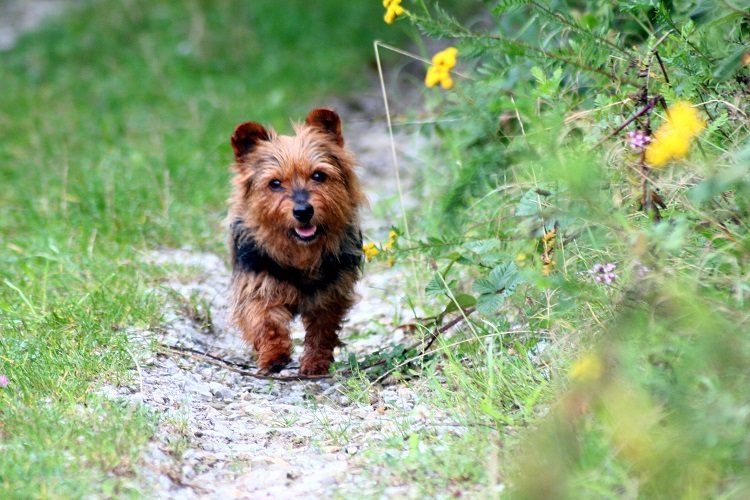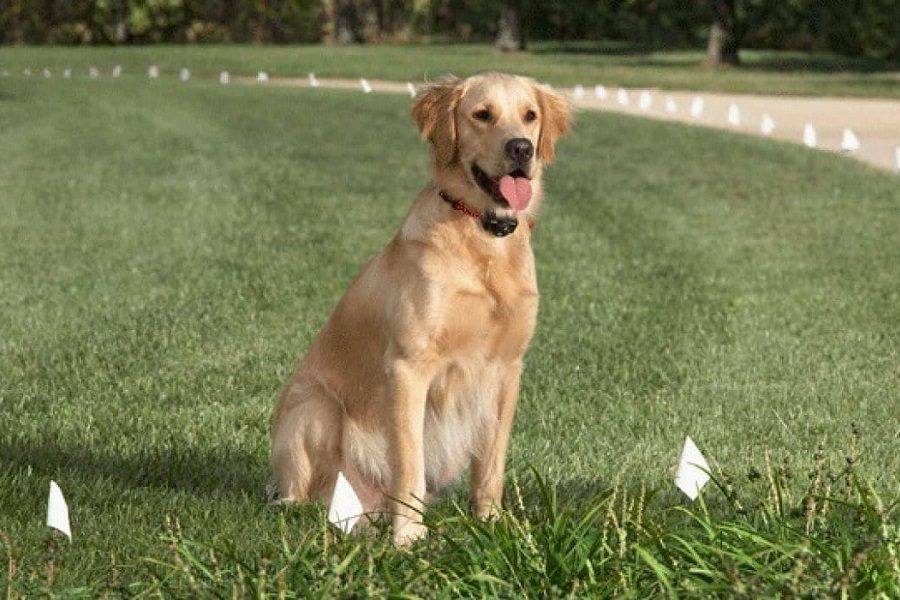Last Updated: 2 years ago
The rise in incidences of human diabetes has been mirrored in the canine world.
This has given rise to a considerable amount of research into the whole subject of dog diabetes. As a result of this, we are now able to state which breeds of dog are most likely to succumb to the condition.
In this article, we reveal the nine dog breeds that are most likely to contract diabetes mellitus.
The Most At Risk Dog Breeds for Diabetes

Before we consider the most at-risk breeds, it is important to note that a dog that is overweight and gets little exercise is going to be a prime candidate for diabetes, no matter what breed he belongs to.
Dogs are also more likely to succumb to diabetes as they get older.
Research into the subject of canine diabetes reveals that there are several breeds of dogs that are more susceptible to diabetes than others. The seven breeds that top this unenviable list are:
- Miniature Schnauzers
- Australian Terriers
- Standard Schnauzers
- Dachshunds
- Poodles
- Keeshonds
- Samoyeds
There are two further breeds that are most susceptible to developing juvenile-onset diabetes:
- Golden Retrievers
- Keeshonds
Signs Your Dog May Have Diabetes

The first sign that you might notice in your dog is a change in his eating and drinking habits.
Your dog will drink a lot more water than normal as the kidneys work overtime to flush the excess glucose from the dog’s body. Even though the dog will probably be eating well, it will also usually be losing weight as a result of the condition.
As a result of drinking more water, the dog will also be urinating far more frequently. Here are some other telltale signs of diabetes that you may notice in your dog:
- Sweet-smelling breath
- Dehydration despite an increased water intake
- Fatigue and lethargy
- Susceptibility to urinary tract infections and chronic skin infections
- Regular vomiting
- The development of cataracts
Minimizing Diabetes Risk in Dogs
An overweight or obese dog is at a much greater risk of developing diabetes than a normal-weight canine.
For that reason, one of the most important things you can do to ensure that your dog has a minimal diabetes risk is to keep his weight down. Do not overfeed your dog; keep the giving of treats to a minimum.
Your dog needs regular exercise to help keep his weight down. In this respect, dogs are just like humans. If they consume more calories than they expend, they will gain excess body fat. A 40-minute walk each day will help burn those calories off.
Another important factor is responsible breeding. If a dog has an inherited form of diabetes, it should not be used for breeding purposes.
Another important measure you can take to lessen the chances of your dog getting diabetes is to have your female dog spayed.
When the dog is going through her regular cycle, her levels of progesterone will greatly increase, which suppresses the release of insulin. This, in turn, leads to an excess of blood sugar in the bloodstream.
The At Risk Breeds
Miniature Schnauzer

The Miniature Schnauzer is a small, sturdy, muscular dog that originated in Germany. It is the result of the breeding of a Standard Schnauzer with the Affenpinscher and the Poodle.
It has been bred in America since 1925. It was intended to be a small vermin hunter that could be more easily kept as a pet.
The Miniature Schnauzer has a strong, well-arched neck, a short straight back, straight legs, round feet with thick black pads, and a high, docked tail that is carried high.
A long, rectangular head and a strong muzzle are accentuated by a bushy beard and mustache. The ears are set high on the head—erect and pointed if cropped or small, V-shaped and folded close to the head if uncropped.
This is a moderate, spirited, playful, and athletic dog. It requires daily exercise, but that may come in many forms, from a walk to an exuberant play session.
In addition to being prone to diabetes mellitus, the miniature Schnauzer is susceptible to hip dysplasia, epilepsy, and patellar luxation.
Australian Terrier

The Australian Terrier originated in the Australian state of Tasmania. Its forebears were all-purpose companions, killing vermin and snakes, controlling livestock, and sounding the alarm at intruders.
This root stock was bred with a range of introduced dogs to produce what we know as the modern Australian Terrier.
Around 1900, the Australian Terrier made its way to England. It came to America in 1925. Australian Terriers are plucky, tough, fun-loving, and adventurous.
They are eager to please, making them one of the more obedient terriers. They get along well with other dogs but are reserved when it comes to strange humans.
The Australian Terrier requires a moderate walk or a rollicking game each day. Health concerns beyond diabetes include patellar luxation.
Standard Schnauzers

The Schnauzer is also known as the Standard Schnauzer. This is the oldest variety of the three varieties of the Schnauzer, the others being the miniature and the giant. This dog is of German origin.
The Schnauzer is an attractive, robust, intelligent, and playful dog, which makes a good companion. It is generally good for children. This dog enjoys plenty of exercise. Its hardy, harsh, wet coat needs a certain amount of stripping and plucking.
It has a strong head, dark, oval-shaped eyes, pointed ears, a broad chest, and a tail that is set on and carried high. The tail is usually docked at three points.
Over and above diabetes mellitus, the Standard Schnauzer is also susceptible to hip dysplasia, epilepsy, and patellar luxation.
Dachshund

The dachshund is of German origin. The modern name Dachshund means ‘Badger Dog.’ It is a tenacious hunter who would follow its quarry into its burrow, pull it out, and kill it.
The Dachshund comes in three coat varieties (longhaired, smooth, and wire-handed) and two sizes (standard and miniature). It has become a popular family dog.
Dachshunds are bold, curious, and always up for adventure. They enjoy hunting, digging, tracking, and going to the ground after a game. It needs a daily romp or a short walk. Extra health concerns over and above diabetes include intervertebral disk disease and dry eye.
Poodles

The poodle originated as a water retriever in Germany. Its hair was shorn in a working pattern and clipped close to make it easier for the dog to swim. The hair on the chest was left longer for warmth and around the joints and tail to protect the tip.
On arrival in France, the poodle was appreciated more as a companion and a circus dog than as a retriever. After World War Two, the poodle became a very popular dog in America.
Poodles are amiable, playful, responsive, and obedient. They are sensitive, tend to be devoted to a single person, and are reserved around strangers. They are generally good with other pets. However, the smaller variety has a tendency to bark a lot.
A poodle needs mental and physical exercise daily. A standard poodle will require a long walk every day. The smaller varieties can get by with a short walk or indoor games.
Other health risks for poodles are eyelid problems, Legg-Perthes, patellar luxation, progressive retinal atrophy, epilepsy, and sebaceous adenitis.
Keeshonds

The Keeshond is of Dutch origin. It was well established by the 18th century as a companion and a watchdog. The Keeshond is now the national dog of the Netherlands.
This is an energetic, playful dog that has an attentive, loving nature. While ready for adventure, it is also easy-going. It is sensitive and a quick learner, which is friendly to all. Still, the Keeshond makes an alert watchdog.
To keep your Keeshond in good shape, ensure that he gets a brisk walk every day, along with regular vigorous games. Health concerns over and above diabetes include hip dysplasia, epilepsy, and patellar luxation.
Samoyed

The Samoyed originates in Russia. Historically, it was a herder and guardian of reindeer, as well as a hunter of bears and a puller of tow boats and sleighs. The Samoyed became a popular sled dog because it was more tractable than other sled breeds.
The Samoyed is a gentle and playful dog. It is friendly with strangers and, usually, with other dogs too. They are calm indoors but can be mischievous. They are independent and often stubborn, but are generally willing to please.
The Samoyed needs a long walk or jog or a vigorous play session every day. In addition to diabetes, health concerns include hip dysplasia and gastric torsion.
Conclusion
In this article, we have identified the dog breeds that are most prone to diabetes. However, that does not mean that there is an inevitability to the matter.
The actions that you take to take care of your dog are the biggest factor involved. Give your pooch the exercise, attention, and healthy diet that it deserves, and you will have a good chance of keeping diabetes at bay.
Resources:



